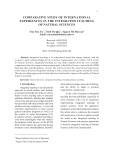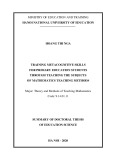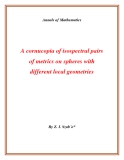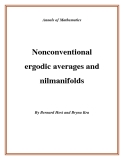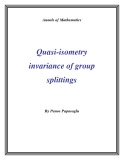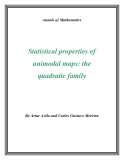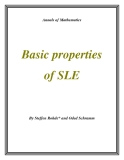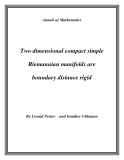Annals of Mathematics
Logarithmic singularity of the
Szeg¨o kernel and a global
invariant of strictly pseudoconvex
domains
By Kengo Hirachi
Annals of Mathematics, 163 (2006), 499–515
Logarithmic singularity of the Szeg¨o kernel and a global invariant of strictly pseudoconvex domains
By Kengo Hirachi*
1. Introduction
This paper is a continuation of Fefferman’s program [7] for studying the geometry and analysis of strictly pseudoconvex domains. The key idea of the program is to consider the Bergman and Szeg¨o kernels of the domains as analogs of the heat kernel of Riemannian manifolds. In Riemannian (or confor- mal) geometry, the coefficients of the asymptotic expansion of the heat kernel can be expressed in terms of the curvature of the metric; by integrating the co- efficients one obtains index theorems in various settings. For the Bergman and Szeg¨o kernels, there has been much progress made on the description of their asymptotic expansions based on invariant theory ([7], [1], [15]); we now seek for invariants that arise from the integral of the coefficients of the expansions. We here prove that the integral of the coefficient of the logarithmic sin- gularity of the Szeg¨o kernel gives a biholomorphic invariant of a domain Ω, or a CR invariant of the boundary ∂Ω, and moreover that the invariant is un- changed under perturbations of the domain (Theorem 1). We also show that the same invariant appears as the coefficient of the logarithmic term of the volume expansion of the domain with respect to the Bergman volume element (Theorem 2). This second result is an analogue of the derivation of a conformal invariant from the volume expansion of conformally compact Einstein mani- folds which arises in the AdS/CFT correspondence — see [10] for a discussion and references.
*This research was supported by Grant-in-Aid for Scientific Research, JSPS.
The proofs of these results are based on Kashiwara’s microlocal analysis of the Bergman kernel in [17], where he showed that the reproducing prop- erty of the Bergman kernel on holomorphic functions can be “quantized” to a reproducing property of the microdifferential operators (i.e., classical ana- lytic pseudodifferential operators). This provides a system of microdifferential equations that characterizes the singularity of the Bergman kernel (which can be formulated as a microfunction) up to a constant multiple; such an argument
KENGO HIRACHI
500
can be equally applied to the Szeg¨o kernel. These systems of equations are used to overcome one of the main difficulties, when we consider the analogy to the heat kernel, that the Bergman and Szeg¨o kernels are not defined as solutions to differential equations.
∂Ω
(cid:1)
Let Ω be a relatively compact, smoothly bounded, strictly pseudoconvex domain in a complex manifold M . We take a pseudo Hermitian structure θ, or a contact form, of ∂Ω and define a surface element dσ = θ ∧ (dθ)n−1. Then we may define the Hardy space A(∂Ω, dσ) consisting of the boundary values of holomorphic functions on Ω that are L2 in the norm (cid:2)f (cid:2)2 = |f |2dσ. The Szeg¨o kernel Sθ(z, w) is defined as the reproducing kernel of A(∂Ω, dσ), which can be extended to a holomorphic function of (z, w) ∈ Ω × Ω and has a singularity along the boundary diagonal. If we take a smooth defining function ρ of the domain, which is positive in Ω and dρ (cid:4)= 0 on ∂Ω, then (by [6] and [2]) we can expand the singularity as
−n + ψθ(z) log ρ(z),
(1.1) Sθ(z, z) = ϕθ(z)ρ(z)
where ϕθ and ψθ are functions on Ω that are smooth up to the boundary. Note that ψθ|∂Ω is independent of the choice of ρ and is shown to gives a local invariant of the pseudo Hermitian structure θ.
Theorem 1. (i) The integral (cid:2)
∂Ω is independent of the choice of a pseudo Hermitian structure θ of ∂Ω. Thus L(∂Ω) = L(∂Ω, θ).
L(∂Ω, θ) = ψθ θ ∧ (dθ)n−1
(ii) Let {Ωt}t∈R be a C∞ family of strictly pseudoconvex domains in M . Then L(∂Ωt) is independent of t.
11),
In case n = 2, we have shown in [13] that
11 are respectively the scalar curva- where ∆b is the sub-Laplacian, R and A11, ture and the second covariant derivative of the torsion of the Tanaka-Webster connection for θ. Thus the integrand ψθ θ ∧ dθ is nontrivial and does depend on θ, but it also turns out that L(∂Ω) = 0 by Stokes’ theorem. For higher di- mensions, we can still give examples of (∂Ω, θ) for which ψθ|∂Ω (cid:4)≡ 0. However, the evaluation of the integral is not easy and, so far, we can only give examples with trivial L(∂Ω) — see Proposition 3 below.
ψθ|∂Ω = 1 24π2 (∆bR − 2 Im A11,
We were led to consider the integral of ψθ by the works of Branson-Ørstead [4] and Parker-Rosenberg [20] on the constructions of conformal invariants from the heat kernel kt(x, y) of the conformal Laplacian, and their CR analogue for CR invariant sub-Laplacian by Stanton [22]. For a conformal manifold
LOGARITHMIC SINGULARITY OF THE SZEG ¨O KERNEL
501
(cid:3)∞
of even dimension 2n (resp. CR manifold of dimension 2n − 1), the integral of the coefficient an of the asymptotic expansion kt(x, x) ∼ t−n j=0 aj(x)tj is shown to be a conformal (resp. CR) invariant, while the integrand andvg does depend on the choice of a scale g ∈ [g] (resp. a contact form θ). This is a natural consequence of the variational formula for the kernel kt(x, y) under conformal scaling, which follows from the heat equation. Our Theorem 1 is also a consequence of a variational formula of the Szeg¨o kernel, which is obtained as a part of a system of microdifferential equations for the family of Szeg¨o kernels (Proposition 3.4).
We next express L(∂Ω) in terms of the Bergman kernel. Take a C∞ volume element dv on M . Then the Bergman kernel B(z, w) is defined as the reproducing kernel of the Hilbert space A(Ω, dv) of L2 holomorphic functions on Ω with respect to dv. The volume of Ω with respect to the volume element B(z, z)dv is infinite. We thus set Ωε = {z ∈ Ω : ρ(z) > ε} and consider the asymptotic behavior of (cid:2)
Ωε
B(z, z) dv Vol(Ωε) =
as ε → +0.
n−1(cid:4)
Theorem 2. For any volume element dv on M and any defining function ρ of Ω, the volume Vol(Ωε) admits an expansion
j=0
(1.2) Vol(Ωε) = Cj εj−n + L(∂Ω) log ε + O(1),
where Cj are constants, L(∂Ω) is the invariant given in Theorem 1 and O(1) is a bounded term.
The volume expansion (1.2) can be compared with that of conformally compact Einstein manifolds ([12], [10]); there one considers a complete Ein- stein metric g+ on the interior Ω of a compact manifold with boundary and a conformal structure [g] on ∂Ω, which is obtained as a scaling limit of g+. For each choice of a preferred defining function ρ corresponding to a conformal scale, we can consider the volume expansion of the form (1.2) with respect to g+. If dimR ∂Ω is even, the coefficient of the logarithmic term is shown to be a conformal invariant of the boundary ∂Ω. Moreover, it is shown in [11] and [8] that this conformal invariant can be expressed as the integral of Branson’s Q-curvature [3], a local Riemannian invariant which naturally arises from con- formally invariant differential operators. We can relate this result to ours via Fefferman’s Lorentz conformal structure defined on an S1-bundle over the CR manifold ∂Ω. In case n = 2, we have shown in [9] that ψθ|∂Ω agrees with the Q-curvature of the Fefferman metric; while such a relation is not known for higher dimensions.
KENGO HIRACHI
502
So far, we have only considered the coefficient L(∂Ω) of the expansion (1.2). But other coefficients may have some geometric meaning if one chooses ρ properly; here we mention one example. Let E → X be a positive Hermitian line bundle over a compact complex manifold X of dimension n − 1; then the unit tube in the dual bundle Ω = {v ∈ E∗ : |z| < 1} is strictly pseudoconvex. We take ρ = − log |z|2 as a defining function of Ω and fix a volume element dv on E∗ of the form dv = i ∂ρ ∧ ∂ρ ∧ π∗dvX , where π∗dvX is the pullback of a volume element dvX on X.
−ε tP (t)dt + f (ε). e
0
Proposition 3. Let B(z, z) be the Bergman kernel of A(Ω, dv). Then the volume of the domain Ωε = {v ∈ E∗|ρ(z) > ε} with respect to the volume element Bdv satisfies (cid:2) ∞ (1.3) Vol(Ωε) =
Here f (ε) is a C∞ function defined near ε = 0 and P (t) is the Hilbert polyno- mial of E, which is determined by the condition P (m) = dim H 0(M, E⊗m) for m (cid:8) 0.
This formula suggests a link between the expansion of Vol(Ωε) and index theorems. But in this case the right-hand side of (1.3) does not contain a log ε term and hence L(∂Ω) = 0. (Note that dv is singular along the zero section, but we can modify it to a C∞ volume element without changing (1.3).) Finally, we should say again that we know no example of a domain with nontrivial L(∂Ω) and need to ask the following:
Question. Does there exist a strictly pseudoconvex domain Ω such that L(∂Ω) (cid:4)= 0?
This paper is organized as follows. In Section 2, we formulate the Bergman and Szeg¨o kernels as microfunctions. We here include a quick review of the theory of microfunctions in order for the readers to grasp the arguments of this paper even if they are unfamiliar with the subject. In Section 3 we recall Kashiwara’s theorem on the microlocal characterization of the Bergman and Szeg¨o kernels and derive a microdifferential relation between the two kernels and a first variational formula of the Szeg¨o kernel. After these preparations, we give in Section 4 the proofs of the main theorems. Finally in Section 5, we prove Proposition 3 by relating Vol(Ωε) to the trace of the operator with the kernel B(λz, w), |λ| ≤ 1. This proof, suggested by the referee, utilizes essentially only the fact that dv is homogeneous of degree 0, and one can considerably weaken the assumption of the proposition — see Remark 5.1. We also derive here, by following Catlin [5] and Zelditch [24], an asymptotic relation between the fiber integral of Bdv and the Bergman kernel of H 0(M, E⊗m); this is a localization of (1.3). I am very grateful to the referee for simplifying the proof of Proposition 3.
LOGARITHMIC SINGULARITY OF THE SZEG ¨O KERNEL
503
2. The Bergman and Szeg¨o kernels as microfunctions
In this preliminary section, we explain how to formulate the theorems in terms of microfunctions, which are the main tools of this paper. We here recall all the definitions and results we use from the theory of microfunctions, with an intention to make this section introductory to the theory. A fundamental reference for this section is Sato-Kawai-Kashiwara [21], but a concise review of the theory by Kashiwara-Kawai [18] will be sufficient for understating the arguments of this paper. For comprehensive introductions to microfunctions and microdifferential operators, we refer to [19], [23] and [16].
2.1. Singularity of the Bergman kernel. We start by recalling the form of singularity of the Bergman kernel, which naturally lead us to the definition of homomorphic microfunctions.
Let Ω be a strictly pseudoconvex domain in a complex manifold M with real analytic boundary ∂Ω. We denote by MR the underlying real manifold and its complexification by X = M × M with imbedding ι : MR → X, ι(z) = (z, z). We fix a real analytic volume element dv on M and define the Bergman kernel as the reproducing kernel of A(Ω, dv) = L2(Ω, dv) ∩ O(Ω), where O denotes the sheaf of holomorphic functions. Clearly we have B(z, w) ∈ O(Ω×Ω), while we can also show that B(z, w) has singularity on the boundary diagonal. If we take a defining function ρ(z, z) of ∂Ω, then at each boundary point p ∈ ∂Ω, we can write the singularity of B(z, w) as
−n−1 + ψ(z, w) log ρ(z, w).
B(z, w) = ϕ(z, w)ρ(z, w)
Here ρ(z, w) is the complexification of ρ(z, z) and ϕ, ψ ∈ OX,p, where p is identified with ι(p) ∈ X. Moreover it is shown that this singularity is locally determined: if Ω and (cid:5)Ω are strictly pseudoconvex domains that agree near a boundary point p, then BΩ(z, w) − B(cid:5)Ω(z, w) ∈ OX,p. See [17] and Remark 3.2 below. Such an OX modulo class plays an essential role in the study of the system of differential equations and is called a holomorphic microfunction, which we define below in a more general setting.
2.2. Microfunctions: a quick review. Microfunctions are the “singular parts” of holomorphic functions on wedges at the edges. To formulate them, we first introduce the notion of hyperfunctions, which are generalized functions obtained by the sum of “ideal boundary values” of holomorphic functions.
m(cid:4)
For an open set V ⊂ Rn and an open convex cone Γ ⊂ Rn, we denote by V + iΓ0 ⊂ Cn an open set that asymptotically agrees with the wedge V + iΓ at the edge V . The space of hyperfunctions on V is defined as a vector space of formal sums of the form
j=1
f (x) = (2.1) Fj(x + iΓj0),
KENGO HIRACHI
504
(cid:3)
−1
−1
−1 − (x − i0)
where Fj is a holomorphic function on V + iΓj0, that allow the reduction Fj(x + iΓj0) + Fk(x + iΓk0) = Fjk(x + iΓjk0), where Γjk = Γj ∩ Γk (cid:4)= ∅ and Fjk = Fj|Γjk + Fk|Γjk, and its reverse conversion. We denote the sheaf of hyperfunctions by B. Note that if each Fj is of polynomial growth in y at y = 0 (i.e., |Fj(x + iy)| ≤ const.|y|−m), then j limΓj(cid:5)y→0 Fj(x + iy) converges to a distribution (cid:5)f (x) on V and such a hyperfunction f (x) can be identified with the distribution (cid:5)f (x). When n = 1, we only have to consider two cones Γ± = ±(0, ∞) and we simply write (2.1) as f (x) = F+(x + i0) + F−(x − i0). For example, the delta function and the Heaviside function are given by (cid:6) (cid:7) δ(x) = (−2πi) (x + i0)
−1
and (cid:6) (cid:7) log(x + i0) − log(x − i0) ,
H(x) = (−2πi) where log z has slit along (0, ∞).
We next define the singular part of hyperfunctions. We say that a hyper- function f (x) is micro-analytic at (x0; iξ0) ∈ iT ∗Rn \ {0} if f (x) admits, near x0, an expression of the form (2.1) such that (cid:14)ξ0, y(cid:15) < 0 for any y ∈ ∪jΓj. The sheaf of microfunctions C is defined as a sheaf on iT ∗Rn \ {0} with the stalk at (x0; iξ0) given by the quotient space
C (x0;iξ0) = Bx0/{f ∈ Bx0 : f is micro-analytic at (x0; iξ0)}. Since the definition of C is given locally, we can also define the sheaf of micro- functions CM on iT ∗M \ {0} for a real analytic manifold M .
We now introduce a subclass of microfunctions that contains the Bergman and Szeg¨o kernels. Let N ⊂ M be a real hypersurface with a real analytic defining function ρ(x) and let Y be its complexification given by ρ(z) = 0 in X. Then, for each point p ∈ N , we consider a (multi-valued) holomorphic function of the form
−m + ψ(z) log ρ(z),
u(z) = ϕ(z)ρ(z)
N |M admits a unique expansion
−∞(cid:4)
(2.2) where ϕ, ψ ∈ OX,p and m is a positive integer. A class modulo OX,p of u(z) is called a germ of a holomorphic microfunction at (p; iξ) ∈ iT ∗ N M \ {0} = {(z; λdρ(z)) ∈ T ∗M : z ∈ N, λ ∈ R \ {0}}, and we denote the sheaf of holo- morphic microfunctions on iT ∗ N M \ {0} by C N |M . For a holomorphic micro- function u, we may assign a microfunction by taking the “boundary values” from ± Im ρ(z) > 0 with signature ±1, respectively, as in the expression of δ(x) above, which corresponds to (−2πi z)−1. Thus we may regard C N |M as a subsheaf of CM supported on iT ∗ N M \ {0}. With respect to local coordinates (x(cid:7), ρ) of M , each u ∈ C
(cid:7) u(x
(cid:7) aj(x
j=k
(2.3) , ρ) = )Φj(ρ),
LOGARITHMIC SINGULARITY OF THE SZEG ¨O KERNEL
505
where aj(x(cid:7)) are real analytic functions and (cid:8)
Φj(t) = for j ≥ 0, for j < 0. j! t−j−1 (−1)j (−j−1)! t−j−1 log t
x , where Dα
x = (∂/∂x1)α1 · · · (∂/∂xn)αn,
If u (cid:4)= 0 we may choose k so that ak(x(cid:7)) (cid:4)≡ 0 and call k the order of u; moreover, if ak(x(cid:7)) (cid:4)= 0 then we say that u is nondegenerate at (x(cid:7), 0) ∈ N . A differential operator (cid:4) P (x, Dx) = aα(x)Dα
with real analytic coefficients acts on microfunctions; it is given by the appli- cation of the complexified operator P (z, Dz) to each Fj(z) in the expression (2.1). Moreover, at (p; i(1, 0, . . . , 0)) ∈ iT ∗Rn, we can also define the inverse operator D−1 x1 of Dx1 by taking indefinite integrals of each Fj in z1. The microdifferential operators are defined as a ring generated by these operators. A germ of a microdifferential operator of order m at (x0; iξ0) ∈ iT ∗Rn is a series of holomorphic functions {Pj(z, ζ)}−∞ j=m defined on a conic neighborhood U of (x0; iξ0) in T ∗Cn satisfying the following conditions:
K for any j ∈ N = {0, 1, 2, . . . }.
(1) Pj(z, λζ) = λjP (z, ζ) for λ ∈ C \ {0}; (2) For each compact set K ⊂ U , there exists a constant CK > 0 such |P−j(z, ζ)| ≤ j! Cj that supK
(cid:3)
z Q(z, ζ),
ζ P (z, ζ))Dα
α∈Nn (cid:4)
∗
The series {Pj} is denoted by P (x, Dx), and the formal series P (z, ζ) = Pj(z, ζ) is called the total symbol, while σm(P ) = Pm(z, ζ) is called the principal symbol. The product and adjoint of microdifferential operators can be defined by the usual formulas of symbol calculus: (cid:4) (P Q)(z, ζ) = (Dα
z Dα
ζ P (z, −ζ).
α∈Nn
P (z, ζ) = Dα 1 α! (−1)|α| α!
It is then shown that P is invertible on a neighborhood of (x0; iξ0) if and only if σm(P )(x0, iξ0) (cid:4)= 0.
While these definitions based on the choice of coordinates, we can in- troduce a transformation law of microdifferential operators under coordinate changes and define the sheaf of the ring microdifferential operators EM on iT ∗M for real analytic manifolds M . It then turns out that the adjoint de- pends only on the choice of volume element dx = dx1 ∧ · · · ∧ dxn.
The action of differential operators on microfunctions can be extended to the action of microdifferential operators so that CM is a left EM -module. This is done by using the Laurent expansion of P (z, ζ) in ζ and then substituting Dz and D−1 z1 , or by introducing a kernel function associated with the symbol (analogous to the distribution kernel of a pseudodifferential operator). Then
KENGO HIRACHI
N |M becomes an EM -submodule of CM . We can also define the right action of C EM on CM ⊗π−1vM , where vM is the sheaf of densities on M and π : iT ∗M → M is the projection. It is given by (udx)P = (P ∗u)dx, where the adjoint is taken with respect to dx (here P ∗ depends on dx, but (P ∗u)dx is determined by udx).
506
We also consider microdifferential operators with a real analytic para- meter, that is, a P = P (x, t, Dx, Dt) ∈ EM ×R that commutes with t. This is equivalent to saying that the total symbol of P is independent of the dual variable of t; so we denote P by P (x, t, Dx). Note that P (x, t, Dx), when t is regarded as a parameter, acts on CM ⊗ π−1vM from the right.
2.3. Microfunctions associated with domains. Now we go back to our original setting where M is a complex manifold and N = ∂Ω. We have already seen that the Bergman kernel determines a section of C ∂Ω|M , which we call the local Bergman kernel B(x). Here x indicates a variable on MR. Note that the local Bergman kernel is defined for a germ of strictly pseudoconvex hypersurfaces. Similarly, we can define the local Szeg¨o kernel : if we fix a real analytic surface element dσ on ∂Ω and define the Szeg¨o kernel, then the coefficients of the expansion (1.1) are shown to be real analytic and to define a section S(x) of C ∂Ω|M ; see Remark 3.2 below. We sometimes identify the surface element dσ with the delta function δ(ρ(x)), or δ(ρ(x))dv, normalized by dρ ∧ dσ = dv. Note that the microfunction δ(ρ(x)) corresponds to the holomorphic microfunction (−2πiρ(z, w))−1 mod OX , which we denote by δ[ρ]. Similarly, the Heaviside function H(ρ(x)) corresponds to a section H[ρ] of ∂Ω|M , which is represented by (−2πi)−1 log ρ(z, w). C
Our main object Vol(Ωε) can also be seen as a holomorphic microfunction. In fact, since u(ε) = Vol(Ωε) is a function of the form u(ε) = ϕ(ε)ε−n + ψ(ε) log ε, where ϕ and ψ are real analytic near 0, we may complexify u(ε) and define a germ of a holomorphic microfunction u((cid:5)ε) ∈ C{0}|R at (0; i). Note that Vol(Ωε) ∈ C{0}|R is expressed as an integral of the local Bergman kernel: (cid:2)
(2.4) B(x)H[ρ − ε](x)dv(x).
∂ (cid:5)Ω|(cid:9)M , where
Here H[ρ − ε](x) is a section of C
(cid:5)Ω = {(x, ε) ∈ (cid:9)M = M × R : ρ(x) > ε}.
∂ (cid:5)Ω|(cid:9)M defined globally in x for small ⊗ π−1vM , we can define the integral of
∂Ω|M
See Remark 2.2 for the definition of this integral. More generally, for a section u(x, ε) of C
ε and a global section w(x)dx of C microfunction (cid:2)
u(x, ε)w(x)dx
LOGARITHMIC SINGULARITY OF THE SZEG ¨O KERNEL
507
at (0; i) ∈ iT ∗R, which takes values in C{0}|R. For such an integral, we have a formula of integration by parts, which is clear from the definition of the action of microdifferential operators in terms of kernel functions [19].
Lemma 2.1. If P (x, ε, Dx) is a microdifferential operator defined on a neighborhood of the support of u(x, ε), then (cid:2) (cid:2) (cid:6) (cid:7) (cid:6) (cid:7) P u wdx = u wdx P . (2.5)
(cid:7) , (cid:5)ρ) d(cid:5)ρdσ(x
(cid:7) B(x
(cid:2)
(cid:7) log((cid:5)ρ − (cid:5)ε)λ(x
∂Ω
γ1
(2.6) , (cid:5)ρ) ), f ((cid:5)ε) = Remark 2.2. We here recall the definition of the integral (2.4) and show that it agrees with Vol(Ωε). For a general definition of the integral of mi- crofunctions, we refer to [19]. Write dv = λdρ ∧ dσ and complexify λ(x(cid:7), ρ) to λ(x(cid:7), (cid:5)ρ) for (cid:5)ρ ∈ C near 0. Then, define a holomorphic function f ((cid:5)ε) on Im (cid:5)ε > 0, |(cid:5)ε| (cid:19) 1, by the path integral (cid:2) 1 2πi
where γ1 is a path connecting a and b, with a < 0 < b, such that the image is contained in 0 < Im (cid:5)ρ < Im (cid:5)ε except for both ends. Then (2.4) is given by f (ε + i0) ∈ CR, (0;i), which is independent of the choice of a, b and γ. We now show f (ε + i0) = Vol(Ωε) as a microfunction. For each (cid:5)ε with Im (cid:5)ε > 0, choose another path connecting b and a so that γ2γ1 is a closed path surrounding (cid:5)ε in the positive direction. Since the integral along γ2 gives a function that can be analytically continued to 0, we may replace γ1 in (2.6) by γ2γ1 without changing its OC,0 modulo class. Now restricting (cid:5)ε to the positive real axis, and letting the path γ2γ1 shrink to the line segment [ε, b], we see that f (ε) agrees with Vol(Ωε) modulo analytic functions at 0.
2.4. Quantized contact transformations. We finally recall a property of holomorphic microfunctions that follows from the strictly pseudoconvex- ity of ∂Ω. Let z be local holomorphic coordinates of M . Then we write P (x, Dx) = P (z, Dz) (resp. P (z, Dz)) if P commutes with zj and Dzj (resp. zj and Dzj ). Similarly for P (x, t, Dx, Dt) ∈ EM ×R we write, e.g., P (x, t, Dx, Dt) = P (z, t, Dz) if P commutes with zj, Dzj and t. Clearly, the class of operators P (z, Dz) and P (z, Dz) is determined by the complex structure of M .
Lemma 2.3. Let N be a strictly pseudoconvex hypersurface in M with a defining function ρ. Then for each section u of C N |M , there exists a unique microdifferential operator R(z, Dz) such that u = R(z, Dz)δ[ρ]. Moreover, u and R have the same order, and u is nondegenerate if and only if R is invertible.
Note that the same lemma holds when δ[ρ] is replaced by H[ρ], or more N |M , except for the statement generally, by a nondegenerate section u of C about the order.
KENGO HIRACHI
508
The strictly pseudoconvexity of N implies that the projection p1 : T ∗ Y X ⊂ T ∗(M × M ) → T ∗M is a local biholomorphic map, where Y is the complexifi- cation of N in X. The surjectivity and the injectivity of p1 imply the existence and uniqueness of R(z, Dz), respectively. If we apply the same argument for Y X → T ∗M and a contact (or z, we obtain a local biholomorphic map p2 : T ∗ −1 homogeneous symplectic) transformation φ(z, ζ) = p1 ◦ p 2 (z, −ζ). Then, for each nondegenerate u, the lemma above gives a map Φ : P (z, Dz) (cid:21)→ Q(z, Dz) such that (P − Q∗)u = 0, where the adjoint is taken with respect to |dz|2. This is an isomorphism of the rings and satisfies σm(Φ(P )) ◦ φ = σm(P ) if P has order m; hence Φ is called a quantized contact transformation with a generating function u. It is shown that a quantization of φ determines a generating func- tion uniquely up to a constant multiple. Chapter 1 of [23] is a good reference for this subject.
3. Kashiwara’s analysis of the kernel functions
In this section we recall Kashiwara’s analysis of the Bergman kernel and its analogy to the Szeg¨o kernel. Then we derive some microdifferential equations satisfied by these kernels.
3.1. A relation between the local Bergman and Szeg¨o kernels. Under the formulation of the previous section, Kashiwara’s theorem [17] for the Bergman kernel and its analogy to the Szeg¨o kernel can be stated as follows:
Theorem 3.1. (i) The local Bergman kernel satisfies (cid:6) B = 0 (cid:7) P (z, Dz) − Q(z, Dz)
for any pair of microdifferential operators P (z, Dz) and Q(z, Dz) such that
(3.1) (H[ρ]dv)(P (z, Dz) − Q(z, Dz)) = 0.
Moreover, the local Bergman kernel is uniquely determined by this property up to a constant multiple. (ii) The local Szeg¨o kernel satisfies (cid:6) (cid:7) S = 0 P (z, Dz) − Q(z, Dz)
for any pair of microdifferential operators P (z, Dz) and Q(z, Dz) such that
(3.2) (δ[ρ]dv)(P (z, Dz) − Q(z, Dz)) = 0.
Moreover, the local Szeg¨o kernel is uniquely determined by this property up to a constant multiple.
LOGARITHMIC SINGULARITY OF THE SZEG ¨O KERNEL
509
Remark 3.2. In [17], Kashiwara stated (i) and gave its heuristic proof, which can be equally applied to (ii). Also, as a premise for this theorem, he stated the real analyticity of the coefficients of the asymptotic expansion of the Bergman kernel, though the proof was not published. Now a proof of this theorem and claim, based on Kashiwara’s lectures, is available in Kaneko’s lecture notes [16]; the arguments there can also be applied to the case of the Szeg¨o kernel.
∗ ∗ − Q
Take holomorphic coordinates z and write dv = ϕ|dz|2. Then (3.1) can be rewritten as
)ϕH[ρ] = 0, (P
where the adjoint is taken with respect to |dz|2. It follows that the maps P ∗(z, Dz) (cid:21)→ Q(z, Dz) and Q(z, Dz) (cid:21)→ P ∗(z, Dz) are the quantized contact transformations generated by ϕH[ρ] and B, respectively, and are the inverse of each other. Thus we can say that the theorem states the reproducing prop- erty of the kernel on microdifferential operators. In particular, we see that the uniqueness statement of the theorem follows from that of the generating function. From Theorem 3.1, we can easily derive a microdifferential relation be- tween the local Bergman and Szeg¨o kernels.
Proposition 3.3. Let R(z, Dz) be the microdifferential operator such that (H[ρ]dv)R = δ[ρ]dv. Then RS = B.
−1P R − Q)S = 0
Proof. We first show that (P (z, Dz) − Q(z, Dz))RS = 0 for any pair P and Q satisfying (H[ρ]dv)(P − Q) = 0. Noting that Q(z, Dz) commutes with R(z, Dz), we see from H[ρ]dv = (δ[ρ]dv)R−1 that (δ[ρ]dv)(R−1P R − Q) = 0. Since R−1P R is an operator of a z-variable, Theorem 3.1 implies
(R
and thus (P − Q)RS = 0. Now by the uniqueness statement of Theorem 3.1, we have B = c RS for a constant c.
(cid:7)
(cid:7) · z
It remains to show that c = 1. This can be done by computing explicitly the leading term of these kernels. Take local coordinates z = (z(cid:7), zn) such that the boundary ∂Ω is locally given by the defining function
+ F (z, z), F = O(|z|3). ρ0(z, z) = zn + zn − z
Then write ρ = e−f (z,z)ρ0 and dv = eg(z,z)dV , where dV is the standard volume element on Cn. Since Ω is osculated at 0 to the third order by the Siegel domain, we see that
−gρ
−n−1 0
−n −f −gρ e 0
(cid:6) (cid:6) (cid:7) 1 + O(|z|) and S = (cid:7) 1 + O(|z|) . B = n! πn e (n − 1)! πn
KENGO HIRACHI
510
On the other hand, setting f0 = f (0, 0) and g0 = g(0, 0), we have ef0DznegH[ρ] = egδ[ρ] + u for a degenerate germ u ∈ C ∂Ω|M at (0; idρ). Thus R(z, Dz) = −ef0Dzn + P (z, Dz), where P has order at most 1 and σ1(P )(z, ζ) vanishes at (0; idρ). Using the expression of S above, we have
−gρ
−n−1 0
(cid:6) (cid:7) 1 + O(|z|) , RS = −ef0DznS + P S = n! πn e
which implies c = 1.
3.2. Variational formula of the local Szeg¨o kernel. Let {Ωt}t∈I be a real analytic family of strictly pseudoconvex domains, where I ⊂ R is an open interval. Here a real analytic family means that (cid:5)Ω = {(x, t) ∈ (cid:9)M = M × I : x ∈ Ωt} admits a real analytic defining function ρt(x) such that dxρt(x) (cid:4)= 0 on ∂ (cid:5)Ω. If we fix ρt, we can assign for each ∂Ωt a surface element dσt by δ[ρt]dv. We here consider the microdifferential equations for the family of the local Szeg¨o kernels of (∂Ωt, dσt).
∂ (cid:5)Ω|(cid:9)M such that, for each t, St(x) gives the local Szeg¨o kernel of (∂Ωt, dσt). Moreover, St(x) satisfies
Proposition 3.4. There exists a section St(x) of C
(cid:6) (3.3) (cid:7) P (z, t, Dz) − Q(z, Dz, Dt) St(x) = 0
for any pair of microdifferential operators P (z, t, Dz) and Q(z, Dz, Dt) such that (cid:6) = 0, (δ[ρt]d(cid:5)v) (cid:7) P (z, t, Dz) − Q(z, Dz, Dt)
where d(cid:5)v = dv ∧ dt is a volume element on (cid:9)M . In particular, if R(z, t, Dz) satisfies Dtδ[ρt]dv = (δ[ρt]dv)R(z, t, Dz), then
(3.4) −DtSt = R(z, t, Dz)St.
An analogous proposition for the local Bergman kernel was given in [14], where we considered the family of local Bergman kernels Bt(x) of (Ωt, |dz|2) for domains in Cn and obtained exactly the same statement for Bt with H[ρt]|dz|2 in place of δ[ρt]dv. In particular, we have
(3.5)
−DtBt = (cid:5)R(z, t, Dz)Bt for (cid:5)R satisfying DtH[ρt]|dz|2 = (H[ρt]|dz|2) (cid:5)R(z, t, Dz). We here use Proposi- tion 3.3 to translate this formula into the one for St.
Proof. First note that the ring of operators of the form Q(z, Dz, Dt) is the ring generated by z1, . . . , zn, Dz1, . . . , Dzn, Dt, and hence it suffices to prove (3.3) when Q is one of these generators. For zj and Dzj , this is clear from Theorem 3.1. To prove the case Q = Dt, take A(z, t, Dz) such that
LOGARITHMIC SINGULARITY OF THE SZEG ¨O KERNEL
511
δ[ρt]dv = (H[ρt]dv)A and compute
(δ[ρt]d(cid:5)v)Dt = (H[ρt]d(cid:5)v)ADt
−1([A, Dt] − (cid:5)RA).
= (H[ρt]d(cid:5)v)[A, Dt] + (H[ρt]d(cid:5)v)DtA = (H[ρt]d(cid:5)v)([A, Dt] − (cid:5)RA) = (δ[ρt]d(cid:5)v)A
RSt = A
−1DtA − Dt)St
= (A
= A Since [t, [Dt, A]] = 0, we have R(z, t, Dz) = A−1( (cid:5)RA − [A, Dt]). On the other hand, Proposition 3.3 implies Bt = ASt and thus −1( (cid:5)RA − [A, Dt])St −1 (cid:5)RA + A −1( (cid:5)R + Dt)Bt − DtSt.
Therefore, by (3.5), we get RSt = −DtSt.
4. Proofs of the main theorems
Now we are ready to prove the main theorems. We first note that the theorems can be reduced to the ones in the real analytic category by approx- imations. The key fact is that the asymptotic expansions up to each fixed order of the Bergman and Szeg¨o kernels are determined by the finite jets of ρ, dσ and dv at each boundary point. Thus, for a domain Ω with C∞ defining function ρ and the contact form θ = i(∂ρ−∂ρ) on ∂Ω, by taking a series of real analytic functions ρj that converge to ρ in Ck-norm for any k, we may express L(∂Ω, θ) as the limit of L(∂Ωj, θj), where Ωj = {ρj > 0}. To reduce Theorem 1 (i) to the real analytic case, we only have to take another sequence of real analytic contact forms {efj θj} approximating a given contact form ef θ so that L(∂Ωj, efj θj) = L(∂Ωj, θj) implies L(∂Ω, ef θ) = L(∂Ω, θ). Similar arguments of approximation can be applied to the other cases. In the following we prove the theorems in the real analytic category.
∂ (cid:5)Ω|(cid:9)M and consider the integral
4.1. Proof of Theorem 1. Taking a real analytic family of defining func- tions ρt(x), we define St(x) to be the local Szeg¨o kernel for the surface element given by δ[ρt]dv. Let (cid:5)Ω = {(x, ε, t) ∈ (cid:9)M = M × R2 : ρt(x) > ε} so that δ[ρt − ε] defines a section of C (cid:2)
A(ε, t) = St(x)δ[ρt − ε](x)dv(x),
−n + ψ(ε, t) log ε
which is well-defined as a germ of C{0}×R|R2 at (0, 0; i(1, 0)). Write
A(ε, t) = ϕ(ε, t)ε
and set Lt = ψ(0, t), which we call the coefficient of ε0 log ε. Then our goal is to prove the independence of Lt from t, because it contains the theorem: For
KENGO HIRACHI
512
the statement (i), we take ρt = etf ρ so that δ[ρ0]dv and δ[ρ1]dv correspond to θ ∧(dθ)n−1 and (cid:5)θ ∧(d(cid:5)θ)n−1 respectively; then L0 = L(∂Ω, θ) and L1 = L(∂Ω, (cid:5)θ) agree. For the statement (ii), we have Lt = L(∂Ωt), which is independent of t. Take a microdifferential operator R(z, t, Dz) such that
Dtδ[ρt]dv = (δ[ρt]dv)R.
Then Proposition 3.4 implies −DtSt = RSt. Using this and (2.5), we have (cid:2)
DtA(t, ε) = Dt St δ[ρt − ε]dv (cid:2)
= (DtSt)δ[ρt − ε] + StDtδ[ρt − ε]dv (cid:2)
= (−RSt)δ[ρt − ε] + StDtδ[ρt − ε]dv (cid:2) (cid:7) (cid:6) . = St − (δ[ρt − ε]dv)R + Dtδ[ρt − ε]dv
∂ (cid:5)Ω|(cid:9)M such that
Since Dtδ[ρt − ε]dv − (δ[ρt − ε]dv)R vanishes at ε = 0, we may take, by using Lemma 4.1 below, a section u of C
Dtδ[ρt − ε]dv − (δ[ρt − ε]dv)R = ε udv.
(cid:2) Hence we have
DtA(t, ε) = ε St(x) u(x, t, ε)dv(x).
The integral on the right-hand side takes value in C{0}×R|R2; thus the right-hand side does not contain an ε0 log ε term. This implies DtLt = 0.
∂ (cid:5)Ω|(cid:9)M such that u = ε v.
Lemma 4.1. Let {Ωε} be a real analytic family of domains in M and ρ(x, ε) be the defining function of (cid:5)Ω = {(x, ε) ∈ M × R : x ∈ Ωε} such that dxρ(x, ε) (cid:4)= 0 on the boundary. If u(x, ε) ∈ C ∂ (cid:5)Ω|(cid:9)M satisfies u(x, 0) = 0 in C ∂Ω0|M , then there exists a germ v ∈ C
j(x, ε). Thus we may set v =
j(x(cid:7), ε)Φj(ρ). a(cid:7)
(cid:3) Proof. Take coordinates (x(cid:7), ρ, ε) for (cid:9)M and expand u as in (2.3) with coefficients aj(x(cid:7), ε). Then u(x(cid:7), ρ, 0) = 0 implies aj(x(cid:7), 0) = 0 so that aj = εa(cid:7) j for real analytic functions a(cid:7)
4.2. Proof of Theorem 2. Take a microdifferential operator R(z, ε, Dz) such that
(4.1) (H[ρ − ε]dv)R = δ[ρ − ε]dv.
(cid:7)
Then (H[ρ]dv)R(z, 0, Dz) = δ[ρ]dv and hence R(z, 0, Dz)S = B by Proposition 3.3. So, applying Lemma 4.1 for Ωε = Ω, we have
(4.2) (x, ε), R(z, ε, Dz)S(x) = B(x) + ε B
LOGARITHMIC SINGULARITY OF THE SZEG ¨O KERNEL
513
∂Ω×R|M ×R. Using (4.1) and (4.2), we compute
where B(cid:7) is a section of C (cid:2) (cid:2) (cid:7) (cid:6) Sδ[ρ − ε]dv = S (H[ρ − ε]dv)R (cid:2)
(cid:7)
= (RS)H[ρ − ε]dv (cid:2)
B H[ρ − ε]dv. = Vol(Ωε) + ε
Since the integral on the right-hand side takes value in C{0}|R, its ε multi- ple cannot contain an ε0 log ε term. Therefore the coefficients of ε0 log ε of (cid:1) S δ[ρ − ε]dv and Vol(Ωε) agree; the former gives L(∂Ω) and the theorem follows.
5. Proof of Proposition 3
j,m √
Let Am(Ω) be the subspace of A(Ω) = A(Ω, dv) consisting of homogeneous functions of degree m (i.e., ϕ(λz) = λmϕ(z) for any λ ∈ C with |λ| ≤ 1). Then, except for the case A0(Ω) = {0}, each Am(Ω) can be identified with H 0(X, E⊗m) and hence has finite dimension dm. We take, for each m, an orthonormal basis ϕ1,m, . . . , ϕdm,m of Am(Ω) and form a complete orthonormal system {ϕj,m}j,m of A(Ω), so that (cid:4) (5.1) B(z, w) = ϕj,m(z)ϕj,m(w).
√ λ z, λ w) for 0 < λ < 1 and thus, using
−ε.
Ω
Ω
(cid:2) (cid:2) It is then clear that B(λz, w) = B( the homogeneity of dv, we get √ √ B( λ z, λ z)dv = B(λz, z)dv, with λ = e Vol(Ωε) =
(cid:3)∞
−1).
−ε)
−1) = P (−Dε)(ε
F (e Again by (5.1), we see that the integral on the right-hand side is given by the m=1 dmλm. Since dm = P (m) for m (cid:8) 0, we have, power series F (λ) = modulo holomorphic functions at ε = 0, −ε) = P (−Dε)((1 − e
The final formula is the Laplace transform of P (t).
Remark 5.1. In the proof above, we have only used the facts that Ω is bounded, that we have λΩ ⊂ Ω if |λ| ≤ 1, and that dv is homogeneous of degree 0. The result still holds if Ω is not pseudoconvex or smooth; ρ does not even need to be continuous.
With the assumption of strictly pseudoconvexity, we can further express the asymptotic expansion as ε → 0 of the integration of B(z, z) on each fiber Ωε(x) of π : Ωε → X in terms of the Bergman kernel on the diagonal Bm(x) of
KENGO HIRACHI
514
H 0(X, E⊗m). The formulas (5.3) and (5.4) below can be seen as a localization of Proposition 3.
2π
−imφS(eiφz, z)dφ, e
First note that the L2-inner product on the space H 0(X, E⊗m), defined with respect to the fiber metric and a volume element dvX on X, is the (1/2π)- multiple of that on the subspace Am(∂Ω) ⊂ A(∂Ω, dσ) consisting of functions of homogeneous degree m, where dσ = i∂ρ ∧ π∗dvX . Thus using the Szeg¨o kernel of A(∂Ω), we may write the Bergman kernels Bm(x) as Fourier series (cid:2)
−1(x).
0
∂Ωε
Ωε
z ∈ ∂Ω ∩ π Bm(x) = (cid:1) (cid:1) f f dσ =
(cid:2) (cid:2) f V f dv for f ∈ A(∂Ω), where V is On the other hand, since the vector field that generates the C-action, we have B(z, z) = V S(z, z) and thus
Ωε(x)
∂Ωε(x)
B(z, z)i∂ρ ∧ ∂ρ = S(z, z)i∂ρ.
−tρa(x, t)dt e
0
Now we use the strictly pseudoconvexity of Ω and write S(z, z) as the Laplace transform (cid:2) ∞ S(z, z) = (5.2)
−εta(x, t)dt e
0
Ωε(x)
of a classical symbol a(x, t) ∈ Sn(X ×R+) with asymptotic expansion a(x, t) ∼ (cid:3)−∞ j=n−1 aj(x)tj at t = ∞ (this is another formulation of the expansion (2.3); cf. [2]). Then we have (cid:2) (cid:2) ∞ B(z, z)i∂ρ ∧ ∂ρ = 2π (5.3)
and
as m → ∞. (5.4) Bm(x) ∼ 2πa(x, m)
0
The latter is just an application of Fourier’s inversion formula to the complex- ification of (5.2): (cid:2) ∞ eitφa(x, t)dt, S(eiφz, z) =
The University of Tokyo, Tokyo, Japan E-mail address: hirachi@ms.u-tokyo.ac.jp
References
[1] T. N. Bailey, M. G. Eastwood, and C. R. Graham, Invariant theory for conformal and
[2]
CR geometry, Ann. of Math. 139 (1994), 491–552. L. Boutet de Monvel and J. Sj¨ostrand, Sur la singularit´e des noyaux de Bergman et de Szeg¨o, Ast´erisque 34-35 (1976), 123–164.
where we have used the fact that ρ(eiφz, z) = −iφ for small φ.
LOGARITHMIC SINGULARITY OF THE SZEG ¨O KERNEL
[3] T. Branson, Sharp inequalities, the functional determinant, and the complementary
series, Trans. Amer. Math. Soc. 347 (1995), 3671–3742.
[4] T. Branson and B. Ørstead, Conformal indices of Riemannian manifolds, Compositio
Math. 60 (1986), 261–293.
[5] D. Catlin, The Bergman kernel and a theorem of Tian, in Analysis and Geometry in Several Complex Variables (Katata, 1997), 1–23, Birkh¨auser Boston, Boston, MA, 1999. [6] C. Fefferman, The Bergman kernel and biholomorphic mappings of pseudoconvex do-
mains, Invent. Math. 26 (1974), 1–65.
[7] ———, Parabolic invariant theory in complex analysis, Adv. in Math. 31 (1979), 131–
262.
[8] C. Fefferman and C. R. Graham, Q-curvature and Poincar´e metrics, Math. Res. Lett.
9 (2002), 139–151.
[9] C. Fefferman and K. Hirachi, Ambient metric construction of Q-curvature in conformal
and CR geometries, Math. Res. Lett. 10 (2003), 819–831.
[10] C. R. Graham, Volume and area renormalizations for conformally compact Einstein
metrics, Rend. Circ. Mat. Palermo, Ser. II, Suppl. 63 (2000), 31–42.
[11] C. R. Graham and M. Zworski, Scattering matrix in conformal geometry, Invent. Math.
152 (2003), 89–118.
[12] M. Henningson and K. Skenderis, The holographic Weyl anomaly, J. High Energy Phys.
7 (1998), Paper 23 (electronic).
[13] K. Hirachi, Scalar pseudo-Hermitian invariants and the Szeg¨o kernel on three-dimen- sional CR manifolds, in Complex Geometry (Osaka, 1990), Lecture Notes in Pure and Appl. Math. 143, 67–76, Dekker, New York, 1993.
[14] ———, The second variation of the Bergman kernel of ellipsoids, Osaka J. Math. 30
(1993), 457–473.
[15] ———, Construction of boundary invariants and the logarithmic singularity in the
Bergman kernel, Ann. of Math. 151 (2000), 151–190.
[16] A. Kaneko, Introduction to Kashiwara’s microlocal analysis for the Bergman kernel,
Lecture Notes in Math., Korea Advanced Institute of Science and Technology, 1989.
[17] M. Kashiwara, Analyse micro-locale du noyau de Bergman, S´eminaire Goulaouic-
Schwartz, ´Ecole Polytech., Expos´e n◦ VIII, 1976–77.
[18] M. Kashiwara and T. Kawai, Introduction to the theory of hyperfunctions, Seminar on Micro-local Analysis, Ann. of Math. Studies 93, 3–38, Princeton Univ. Press, Princeton, NJ, 1979.
[19] M. Kashiwara, T. Kawai, and T. Kimura, Foundation of Algebraic Analysis, Princeton
Math. Series 37, Princeton Univ. Press, Princeton, NJ, 1986.
[20] T. Parker and S. Rosenberg, Invariants of conformal Laplacians, J. Differential Geom.
25 (1987), 199–222.
[21] M. Sato, T. Kawai, and M. Kashiwara, Microfunctions and pseudo-differential equations, in Hyperfunctions and Pseudo-Differential Equations, Lecture Notes in Math. 287, pp. 265–529, Springer-Verlag, New York (1973).
[22] N. Stanton, Spectral invariants of CR manifolds, Michigan Math. J . 36 (1989), 267–288. [23] P. Schapira, Microdifferential Systems in the Complex Domain, Springer-Verlag, New
York, 1985
[24] S. Zelditch, Szeg¨o kernels and a theorem of Tian, Internat. Math. Res. Notices 1998,
no. 6, 317–331.
(Received September 16, 2003)
515

